Sweden's water shortage: What you need to know

It may not be something commonly associated with a northern European nation, but Sweden is currently fretting over water shortages in several parts of the country, and there are already visible consequences. Here's everything you need to know about the situation.
A water shortage… in Sweden?
Yes, you read that correctly, and it's not the first time in recent years. Since the autumn of 2015 large parts of Sweden have had between 100 and 200mm less rain than usual, and 2016 ended up being the driest year in the country for 40 years.
As a result, ground water levels in larger repositories are currently "significantly lower than normal" in about a third of the country, according to the Geological Survey of Sweden (SGU) and "lower than normal" in another large stretch.
"As the map shows the levels are currently far lower than normal in large parts of southern Sweden," SGU hydrogeologist Lars-Ove Lång told The Local.
READ ALSO: Swedish officials dance to make rain. Doesn't work
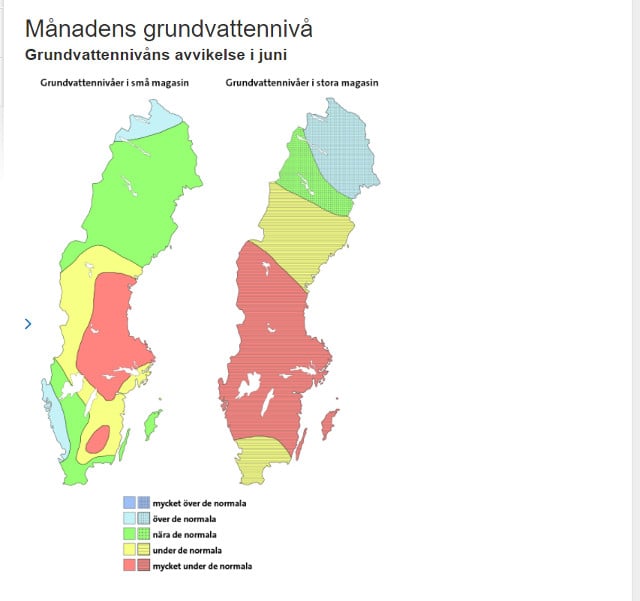
Groundwater levels in Sweden's small (left) and large (right) reserves as of June 2017. Red areas are "significantly lower than normal"; blue areas are "significantly above normal". Photo: SGU
If it rains, will it get better?
Unlikely. Part of the problem is that ground water reserves usually fill up in the winter half of the year while snow melts, but little rain and snow in some parts of the country mean the pre-summer levels were much worse than they had been for several decades. Even with a normal summer's rainfall therefore, the situation wouldn't improve until the winter.
"In general, it's not likely that the amount of downpour that has come this summer so far has improved the situation in the large reserves in affected areas, but we'll have a better idea when a new monthly map (of reserves) is presented next week," Lång explained.
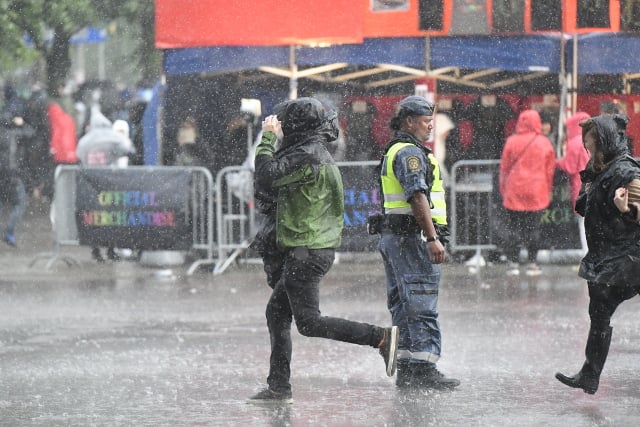
Not good enough, unfortunately. Photo: Björn Larsson Rosvall/TT
What are the consequences?
How the situation impacts you will depend on where you live. Not all public water supplies draw from ground water reserves, and big cities often differ from the countryside.
"If the groundwater is used for the public water supply and the groundwater reserves the supply draws from are low, then that can lead to a water shortage. But it's very distinct between the different areas," the SGU hydrogeologist noted.
"Large and medium sized cities in many cases use surface water or supplement groundwater with surface water, which means they're not as sensitive to low ground water levels. In the countryside, it's important to improve knowledge of groundwater levels, something the government has now flagged up. The consequences can be big for those who use their own wells," he added.
Indeed, the SGU will be given 30 million kronor per year from the Swedish government between 2018 and 2020 for their work mapping groundwater supplies, and as such will be able to measure levels from helicopters in order to provide a more accurate image of the situation, so it's being taken seriously.
A more immediate consequence this summer has been canal boat company Strömma halting their tours on the Göta Canal between Gothenburg and Norsholm for the time being because the water levels are too low. In some areas, water saving measures like bans on filling pools or using sprinklers are in place – check with your local municipality to find out if that's the case.
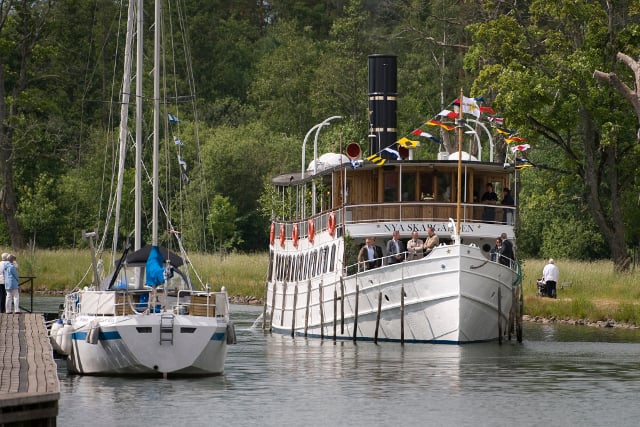
The Göta Canal in happier times. Photo: Anders Wiklund/TT
What can I do to help?
If you're keen to take a proactive approach to the situation, then the simple answer is to use water sparingly when possible (shorter showers, for example). For some people in the countryside meanwhile, the current situation may mean it's time to think more about the long term, according to Lång:
"Save water if the local supply is too low, and it's also generally just a good idea to save water. For those who use a well with a low supply, it could be good to think about some kind of measure to make sure you're less vulnerable."
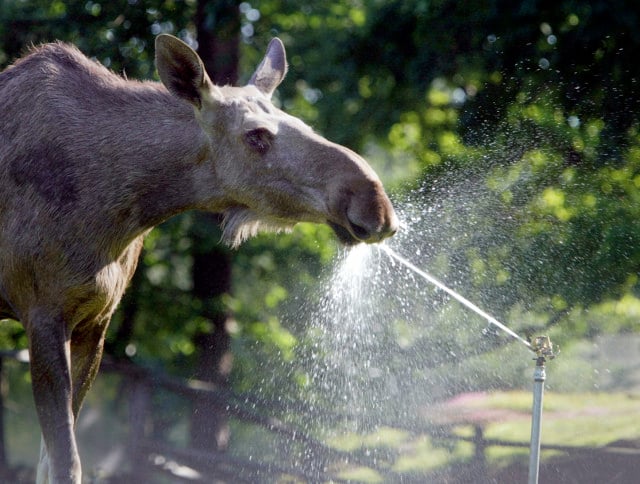
An irresponsible Elk. Photo: Jonas Ekströmer/TT
A useful reminder
The current situation in Sweden is not one that has been typical throughout the country's history, SGU's hydrogeologist pointed out, but it serves as a reminder of how important a natural resource water is (something readers in more drought-prone places like California will no doubt be far more acutely aware of).
"The last two years have highlighted the importance of ground water as a natural resource in our society for the drinking water supply, but under normal conditions and seen from a global perspective Sweden is very fortunately located with the right amount of precipitation and access to surface water and ground water."
"Many countries are fighting significantly more in order to gain access to water for use as drinking water than Sweden," he concluded.
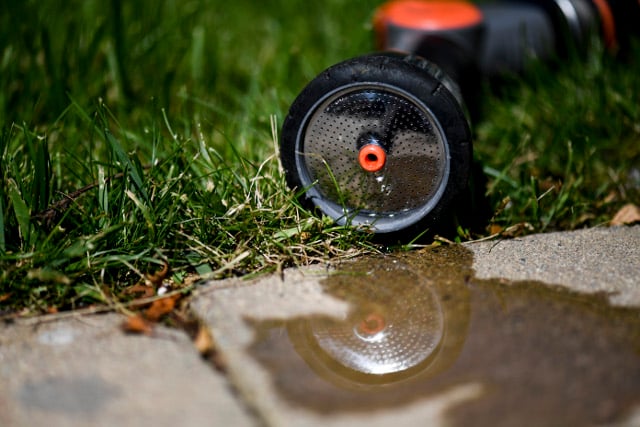
Sweden's location is generally favourable when it comes to water. Photo: Pontus Lundahl/TT
Comments
See Also
A water shortage… in Sweden?
Yes, you read that correctly, and it's not the first time in recent years. Since the autumn of 2015 large parts of Sweden have had between 100 and 200mm less rain than usual, and 2016 ended up being the driest year in the country for 40 years.
As a result, ground water levels in larger repositories are currently "significantly lower than normal" in about a third of the country, according to the Geological Survey of Sweden (SGU) and "lower than normal" in another large stretch.
"As the map shows the levels are currently far lower than normal in large parts of southern Sweden," SGU hydrogeologist Lars-Ove Lång told The Local.
READ ALSO: Swedish officials dance to make rain. Doesn't work

Groundwater levels in Sweden's small (left) and large (right) reserves as of June 2017. Red areas are "significantly lower than normal"; blue areas are "significantly above normal". Photo: SGU
If it rains, will it get better?
Unlikely. Part of the problem is that ground water reserves usually fill up in the winter half of the year while snow melts, but little rain and snow in some parts of the country mean the pre-summer levels were much worse than they had been for several decades. Even with a normal summer's rainfall therefore, the situation wouldn't improve until the winter.
"In general, it's not likely that the amount of downpour that has come this summer so far has improved the situation in the large reserves in affected areas, but we'll have a better idea when a new monthly map (of reserves) is presented next week," Lång explained.

Not good enough, unfortunately. Photo: Björn Larsson Rosvall/TT
What are the consequences?
How the situation impacts you will depend on where you live. Not all public water supplies draw from ground water reserves, and big cities often differ from the countryside.
"If the groundwater is used for the public water supply and the groundwater reserves the supply draws from are low, then that can lead to a water shortage. But it's very distinct between the different areas," the SGU hydrogeologist noted.
"Large and medium sized cities in many cases use surface water or supplement groundwater with surface water, which means they're not as sensitive to low ground water levels. In the countryside, it's important to improve knowledge of groundwater levels, something the government has now flagged up. The consequences can be big for those who use their own wells," he added.
Indeed, the SGU will be given 30 million kronor per year from the Swedish government between 2018 and 2020 for their work mapping groundwater supplies, and as such will be able to measure levels from helicopters in order to provide a more accurate image of the situation, so it's being taken seriously.
A more immediate consequence this summer has been canal boat company Strömma halting their tours on the Göta Canal between Gothenburg and Norsholm for the time being because the water levels are too low. In some areas, water saving measures like bans on filling pools or using sprinklers are in place – check with your local municipality to find out if that's the case.

The Göta Canal in happier times. Photo: Anders Wiklund/TT
What can I do to help?
If you're keen to take a proactive approach to the situation, then the simple answer is to use water sparingly when possible (shorter showers, for example). For some people in the countryside meanwhile, the current situation may mean it's time to think more about the long term, according to Lång:
"Save water if the local supply is too low, and it's also generally just a good idea to save water. For those who use a well with a low supply, it could be good to think about some kind of measure to make sure you're less vulnerable."

An irresponsible Elk. Photo: Jonas Ekströmer/TT
A useful reminder
The current situation in Sweden is not one that has been typical throughout the country's history, SGU's hydrogeologist pointed out, but it serves as a reminder of how important a natural resource water is (something readers in more drought-prone places like California will no doubt be far more acutely aware of).
"The last two years have highlighted the importance of ground water as a natural resource in our society for the drinking water supply, but under normal conditions and seen from a global perspective Sweden is very fortunately located with the right amount of precipitation and access to surface water and ground water."
"Many countries are fighting significantly more in order to gain access to water for use as drinking water than Sweden," he concluded.

Sweden's location is generally favourable when it comes to water. Photo: Pontus Lundahl/TT
Join the conversation in our comments section below. Share your own views and experience and if you have a question or suggestion for our journalists then email us at [email protected].
Please keep comments civil, constructive and on topic – and make sure to read our terms of use before getting involved.
Please log in here to leave a comment.